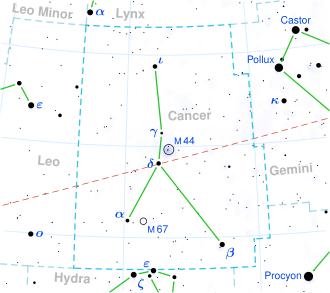Top Qs
Timeline
Chat
Perspective
Epsilon Cancri
Binary star system in the constellation Cancer From Wikipedia, the free encyclopedia
Remove ads
Epsilon Cancri is a white-hued multiple star system in the zodiac constellation of Cancer. Its name is a Bayer designation that is Latinized from ε Cancri, and abbreviated Epsilon Cnc or ε Cnc. This is the brightest member of the Beehive Cluster (or Praesepe)[12] with an apparent visual magnitude of +6.29,[2] which is near the lower limit of visibility with the naked eye. The annual parallax shift of 5.4 mas as seen from Earth yields a distance estimate of approximately 606 light-years (186 pc) from the Sun. The system is moving away from the Sun with a radial velocity of +30 km/s.[10]
The outer pair has the designation WDS J08405+1933. The primary star is designated Epsilon Cancri and the secondary is HD 73711. Epsilon Cancri is itself a spectroscopic binary with components designated Aa (also named Meleph[13]) and Ab. HD 73711 is also suspected of being a spectroscopic binary.[14]
Remove ads
Nomenclature

ε Cancri (Latinised to Epsilon Cancri) is the system's Bayer designation, which originally referred to the entire Beehive Cluster.[15] In his Uranometria, Bayer cited (among others) the name Melleff or Meeleph for the cluster, from Arabic Al Ma'laf, the Stall;[16] as Meleph, this name is also now applied specifically to this star.[17]
In 2016, the IAU organized a Working Group on Star Names (WGSN)[18] to catalog and standardize proper names for stars. The WGSN decided to attribute proper names to individual stars rather than entire multiple systems.[19] It approved the name Meleph for the component Epsilon Cancri Aa on 5 September 2017 and it is now so included in the List of IAU-approved Star Names.[13]
Remove ads
Properties
Epsilon Cancri A is a double-lined spectroscopic binary system with an orbital period of 35.14 days and eccentricity of 0.42.[11] It has a stellar classification of A5 III,[5] which matches an A-type giant star. The spectrum displays the chemically peculiar characteristics of an Am star.[20] Its spectral type has been listed as kA3hA5mF0, indicating the different spectral types shown by spectral lines of calcium, hydrogen, and other metals.[6] Despite the spectral classification, evolutionary models suggest that the star is still on the main sequence, although at the very end of its hydrogen-burning life.[1] The age of the system is estimated to be around 637 million years.[11]
HD 73711 is another Am star, given a stellar classification of F0 III on the basis of its hydrogen absorption lines but a more complete classification of kA3hA5mF0. Although the spectral class would indicate that the star is a giant, models suggest that it is still fusing hydrogen in its core.[3]
Remove ads
Notes
References
Wikiwand - on
Seamless Wikipedia browsing. On steroids.
Remove ads

